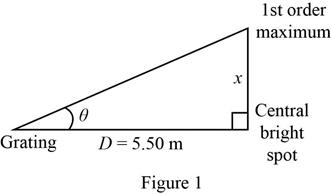
Concept explainers
(a)
The distance between the adjacent slits on the grating.
(a)
Answer to Problem 65P
The distance between the adjacent slits on the grating is
Explanation of Solution
Given that the number of slits per unit length of the grating is
Write the expression for the distance between adjacent slits.
Here,
Conclusion:
Substitute
Therefore, the distance between the adjacent slits on the grating is
(b)
The distance from the central bright spot to the first-order maximum on the screen.
(b)
Answer to Problem 65P
The distance from the central bright spot to the first-order maximum on the screen is
Explanation of Solution
Given that the
Write the expression for the double slit maxima.
Here,
For, first order spectrum,
Let

From Figure 1, write the expression for
Here,
Use equation (II) in (III).
Conclusion:
Substitute
Therefore, the distance from the central bright spot to the first-order maximum on the screen is
(c)
The distance from the central bright spot to the second-order maximum on the screen.
(c)
Answer to Problem 65P
The distance from the central bright spot to the second-order maximum on the screen is
Explanation of Solution
For, first order spectrum,
Use equation (V) in (III).
Conclusion:
Substitute
Therefore, the distance from the central bright spot to the second-order maximum on the screen is
(d)
Whether the assumption
(d)
Answer to Problem 65P
The assumption
Explanation of Solution
The small angle approximation in trigonometry is used in physical problems, when the angles under consideration are very small. If the angles are considerably large, these approximations cannot be applied.
In the given problem, the angle of diffraction corresponding to the first order diffraction is given by equation (II).
Conclusion:
Substitute
For an angle
Therefore, the assumption
Want to see more full solutions like this?
Chapter 25 Solutions
Loose Leaf For Physics With Connect 2 Semester Access Card
 College PhysicsPhysicsISBN:9781305952300Author:Raymond A. Serway, Chris VuillePublisher:Cengage Learning
College PhysicsPhysicsISBN:9781305952300Author:Raymond A. Serway, Chris VuillePublisher:Cengage Learning University Physics (14th Edition)PhysicsISBN:9780133969290Author:Hugh D. Young, Roger A. FreedmanPublisher:PEARSON
University Physics (14th Edition)PhysicsISBN:9780133969290Author:Hugh D. Young, Roger A. FreedmanPublisher:PEARSON Introduction To Quantum MechanicsPhysicsISBN:9781107189638Author:Griffiths, David J., Schroeter, Darrell F.Publisher:Cambridge University Press
Introduction To Quantum MechanicsPhysicsISBN:9781107189638Author:Griffiths, David J., Schroeter, Darrell F.Publisher:Cambridge University Press Physics for Scientists and EngineersPhysicsISBN:9781337553278Author:Raymond A. Serway, John W. JewettPublisher:Cengage Learning
Physics for Scientists and EngineersPhysicsISBN:9781337553278Author:Raymond A. Serway, John W. JewettPublisher:Cengage Learning Lecture- Tutorials for Introductory AstronomyPhysicsISBN:9780321820464Author:Edward E. Prather, Tim P. Slater, Jeff P. Adams, Gina BrissendenPublisher:Addison-Wesley
Lecture- Tutorials for Introductory AstronomyPhysicsISBN:9780321820464Author:Edward E. Prather, Tim P. Slater, Jeff P. Adams, Gina BrissendenPublisher:Addison-Wesley College Physics: A Strategic Approach (4th Editio...PhysicsISBN:9780134609034Author:Randall D. Knight (Professor Emeritus), Brian Jones, Stuart FieldPublisher:PEARSON
College Physics: A Strategic Approach (4th Editio...PhysicsISBN:9780134609034Author:Randall D. Knight (Professor Emeritus), Brian Jones, Stuart FieldPublisher:PEARSON





